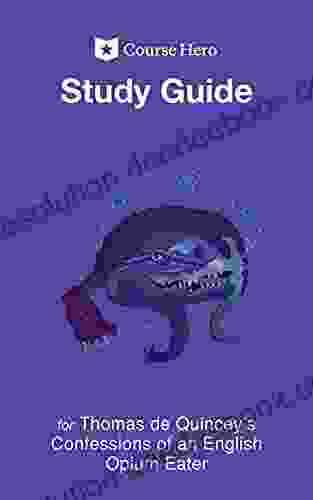Thomas De Quincey's "Confessions of an English Opium-Eater" is a classic work of English literature that has captivated readers for centuries. This study guide will provide you with the tools you need to analyze and appreciate this complex and fascinating work.
4.5 out of 5
| Language | : | English |
| File size | : | 927 KB |
| Print length | : | 32 pages |
| Lending | : | Enabled |
| Screen Reader | : | Supported |
| Paperback | : | 114 pages |
| Reading age | : | 14 years and up |
| Item Weight | : | 12 ounces |
| Dimensions | : | 5.59 x 0.67 x 8.19 inches |
Historical Context
De Quincey's "Confessions" was first published in 1821, at a time when opium use was widespread in England. Opium was used for a variety of purposes, including pain relief, as a stimulant, and as a recreational drug. De Quincey's own experiences with opium began in 1804, when he was a student at Oxford University. He became addicted to the drug and struggled to overcome his addiction for many years.
The "Confessions" is a deeply personal account of De Quincey's experiences with opium. It is also a work of great literary merit, and it has been praised for its vivid imagery, its psychological insights, and its exploration of the nature of addiction.
Themes
The "Confessions" explores a number of important themes, including:
- Addiction: De Quincey's addiction to opium is the central theme of the "Confessions." He vividly describes the pleasures and dangers of opium use, and he explores the psychological and physical effects of addiction.
- Dreams and reality: De Quincey's opium-induced dreams are a major focus of the "Confessions." He describes these dreams in great detail, and he explores their relationship to his waking life.
- The nature of self: De Quincey's experiences with opium lead him to question the nature of self. He explores the relationship between the mind and the body, and he questions the stability of identity.
- The power of language: De Quincey is a master of language, and the "Confessions" is full of vivid imagery and powerful prose. He uses language to explore the complex and often contradictory nature of human experience.
Characters
The "Confessions" is a largely autobiographical work, and the narrator is based on De Quincey himself. However, there are a few other characters who play important roles in the story.
- Ann: Ann is De Quincey's first wife. She is a supportive and loving woman, but she is unable to help De Quincey overcome his addiction.
- Margaret: Margaret is De Quincey's second wife. She is a more independent and assertive woman than Ann, and she helps De Quincey to find a measure of peace and stability.
- The Malay: The Malay is a mysterious figure who appears to De Quincey in a dream. He is a symbol of the power and danger of opium addiction.
Literary Devices
De Quincey uses a variety of literary devices in the "Confessions," including:
- Imagery: De Quincey is a master of imagery, and he uses vivid and powerful language to describe his experiences with opium. His descriptions of opium-induced dreams are particularly striking.
- Metaphor: De Quincey often uses metaphors to compare opium addiction to other experiences. For example, he compares addiction to a prison and to a disease.
- Symbolism: De Quincey uses a number of symbols in the "Confessions," including the Malay, the dream-eater, and the river of oblivion. These symbols represent the power and danger of opium addiction.
- Irony: De Quincey often uses irony to highlight the contradictions of opium addiction. For example, he describes opium as a "divine" drug that can lead to both pleasure and pain.
Study Questions
Here are some study questions that you can use to help you analyze and appreciate "Confessions of an English Opium-Eater":
- What are the main themes of the "Confessions"?
- How does De Quincey describe the effects of opium on the mind and body?
- What is the relationship between dreams and reality in the "Confessions"?
- How does De Quincey explore the nature of self in the "Confessions"?
- What is the significance of the Malay in the "Confessions"?
- How does De Quincey use imagery, metaphor, symbolism, and irony in the "Confessions"?
Thomas De Quincey's "Confessions of an English Opium-Eater" is a complex and fascinating work of literature. It is a valuable resource for anyone who is interested in the nature of addiction, the power of language, or the human condition. This study guide has provided you with the tools you need to analyze and appreciate this classic work.





























































































